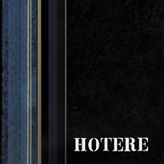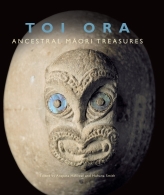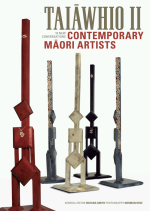Ngā toi me ngā tohunga toi Māori onāianei Contemporary māori art & artists

Pages in this section:
Recent items
 Ralph Hotere / with Kriselle Baker & Vincent O'Sullivan (2008)
Ralph Hotere / with Kriselle Baker & Vincent O'Sullivan (2008)
A beautifully produced large format book on the paintings of Ralph Hotere. Mainly illustrations but includes two essays - by Kriselle Baker and Vincent O'Sullivan.
 Toi ora : ancestral Māori treasures / edited by Arapata Hakiwai and Huhana Smith (2008)
Toi ora : ancestral Māori treasures / edited by Arapata Hakiwai and Huhana Smith (2008)
A beautifully produced, large format book on the paintings of Ralph Hotere. Mainly illustrations, but includes two essays - by Kriselle Baker and Vincent O'Sullivan.
 Taiāwhio II : contemporary Māori artists : 18 new conversations / general editor Huhana Smith with Oriwa Soloman, Awhina Tamarapa and Megan Tamati-Quennell ; photography by Norman Heke.
Taiāwhio II : contemporary Māori artists : 18 new conversations / general editor Huhana Smith with Oriwa Soloman, Awhina Tamarapa and Megan Tamati-Quennell ; photography by Norman Heke.
A beautifully produced large format book on the paintings of Ralph Hotere. Mainly illustrations but includes two essays - by Kriselle Baker and Vincent O'Sullivan.
The carver and the artist : Māori art in the twentieth century / Damian Skinner (2008)
This exciting book by a leading younger art historian charts the growth and development of the Māori modernist art that emerged from the rapid urbanisation of Māori in the midtwentieth century and the complex transition of Māori cultural and social structures from a rural to an urban setting. Artists like Arnold Wilson, Para Matchitt and Selwyn Muru, encouraged by Gordon Tovey and the Education Department, constructed a Māori art that reacted against the customary culture championed by Ngata and attempted to respond to the modern world in which they lived.Introductory chapters set the conservative scene against which the artists reacted and a conclusion points forward to contemporary Māori art which, under the impact of the Maori renaissance of the 1970s, showed a renewed focus on tradition. This book includes a rich selection of reproductions of Māori modernist art, many of which are of brilliant works not widely known and often from the artists' own collections. This important book will attract widespread attention and interest.
Te kāhui o Matariki : contemporary Māori art of Matariki / edited by Libby Hakaraia and Colleen Waata Urlich ; photography by Norman Heke. (2008)
Michael Parekowhai / [edited by Michael Lett and Ryan Moore]. (2007)
Books of interest
Shane Cotton (2004)
Published for the exhibition Shane Cotton: survey 1993-2003 at the City Gallery Wellington.
He Kawenga : a collection of art works from Te Wananga-o-Raukawa
Catalogue of an exhibition held at Pataka Porirua Museum of Arts and Cultures from the Wananga at Otaki.
Taiawhio : conversations with Māori artists / editors Huhana Smith and Oriwa Solomon.
Published to coincide with the exhibition at Te Papa. Extensively illustrated, discusses the philosophies and work of a number of established and emerging artists.
Articles
Note: Some articles are linked to the full text online, others link to the catalogue record for the entire magazine. Where links are to full text, we've noted this.
- 'Extending the Whanau: Lisa Reihana's Digital Marae', Megan Tamati-Quennell. In Art New Zealand, Number 126 / Autumn 2008
- 'Vessels of Meaning: Brett Graham's Whaowhia', Elizabeth Rankin. In Art New Zealand, Number 124 / Spring 2007
- 'Maps and Memories: The Art of Star Gossage', Lisa Reihana. In Art New Zealand, Number 118 / Autumn 2006 (Full text link)
- 'Spirit and Form: The Art of Lorene Taurerewa', Owen Davidson. In Art New Zealand, Number 117 / Summer 2005-2006
- 'Te Hei Tiki: Between Tradition and Modernity', Ngarino Ellis. In Art New Zealand, Number 117 / Summer 2005-2006
- 'Open for Interpretation: The Art of Reuben Paterson', Ngahiraka Mason. In Art New Zealand, Number 116 / Spring 2005 (Full text link)
Older articles:
- Art New Zealand, Number 45 / Summer 1987/88.
An issue of this magazine devoted to Māori art today, in the wake of the Te Māori exhibition. Contains articles on Shona Rapira Davies, Paratene Matchitt, Robyn Kahukiwa, among others. - Art New Zealand, Number 58 / Autumn 1991
Covers the "Kohia Ko Taikaka Anake" exhibit at the National Art Gallery. Contains two articles about this exhibition of developments in Māori art since the contemporary movement was pioneered by Arnold Wilson, Para Matchitt, Fred Graham, Selwyn Muru Sandy Adsett, and John Bevan Ford. - Art New Zealand, Number 59 / Winter 1991
Includes articles about Michael Parekowhai, Robyn Kahukiwa, and Diane Prince. - Art New Zealand, Number 60 / Spring 1991
Witi Ihimaera writes on Emare Karaka.
General Background & Sources
1800s
With the arrival of the Pakeha settlers and traders in the nineteenth century, Māori culture and social life underwent profound changes, which in turn had an impact on way Māori expressed themselves through what in Western terms is 'the arts'.This was not just simply the fact of new technology, such as the metal tools which influenced the style of carving; the adoption of Christianity and the realisation that their culture was under threat created a climate in which the prophets - Te Kooti, Te Whiti, and Rua Kenana, among others, preaching a message of salvation - were able to inspire new forms of expression incorporating both Māori and Pakeha imagery. Notable among these are Rongopai, Te Kooti's famous painted meeting house; Rua Kenana's round house at Maungapohatu; and Te Wepu (the whip), Te Kooti's battle flag. This famous flag, originally made by sisters at the Meeanee Mission and taken by Te Kooti, was then captured by Gilbert Mair, who gave it to the Dominion Museum, where he later found it had been cut up for dusters!
Sources:
1900s
In the early years of last century, the Young Māori Party,led by Western educated liberals such as Sir Apirana Ngataand Peter Buck, encouraged their people to return to traditional,conservative forms of carving and decoration, "turning their backs" onthe prophets, whose ideas they believed were preventing Māori progress.
For many years, these traditional forms were 'Maori Art'.In the 1950's, however, Gordon Tovey, national art supervisor for the Department of Education, gathered together a group of younger Māori artists to train as art specialists.Among these were Ralph Hotere, Fred Graham, Arnold Wilson, and Para Matchitt. Working together, these artists were inspired to work with new forms and motifs.
In particular,Para Matchitt turned back to the motifs of Te Kooti and the Ringatu Church - star, crescent, cross, mountain, and bleedingheart - symbols of trial, hope, and suffering. In some sort of reparation, his powerful work in wood, 'Te Wepu', is now owned by the same institution that destroyed the original.
Sources:
- Paratene Matchitt : the principle of change in Māori art, by Rangihiroa Panoho. In Art New Zealand Summer 1987/88, p.63.
- A blaze of colour : Gordon Tovey, artist educator / Carol Henderson.
Now
Many younger Māori artists, trained in European art institutions, are now successfully combining Māori and Europeanmethods and motifs to create their works, which are often politicalstatements about the present position of Māori. The useof Ringatu motifs is continued by Shane Cotton, but themeans of expression of the younger artists are many and varied.
Some names to look for are: Robyn Kahukiwa, Emily Karaka,John Walsh, Peter Robinson, Lily Laita, Diane Prince, MaureenLander, Kura te Waru Rewiri, Jacqueline Fraser, Brett Graham,and Michael Parekowhai.
Sources:
an excellent source for finding out about contemporary Māori art is Mataora : the living face /edited by Sandy Adsett, Cliff Whiting, and Witi Ihimaera - it gives large illustrations of many artist's works, plus biographies.
Websites
Toi Māori Aotearoa : Māori arts New Zealand
Established in 1996, Toi Māori is a network of ten national art focus committees working under the auspices of a charitable trust, with the support of Creative New Zealand through Te Waka Toi. Provides news of various arts, artist profiles, and links to other Māori websites.
Toi Māori : Māori Arts
The site of Creative New Zealand, provides a background to Māori art, and information about funding, resources, and new happenings.
Contact us
 This page is written and maintained by library staff. We'd be pleased to hear from you about this page - contact us with any feedback.
This page is written and maintained by library staff. We'd be pleased to hear from you about this page - contact us with any feedback.
Page last updated February 2009
